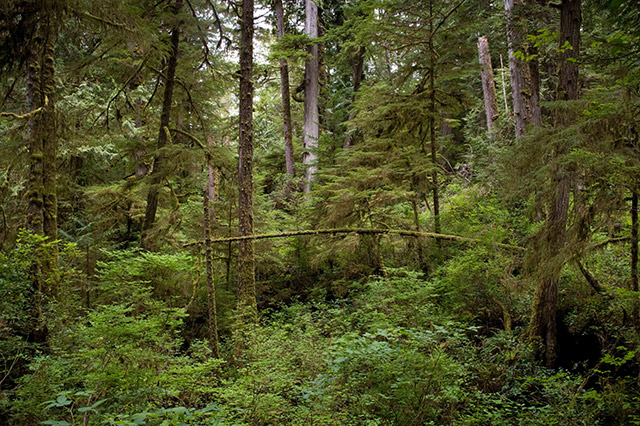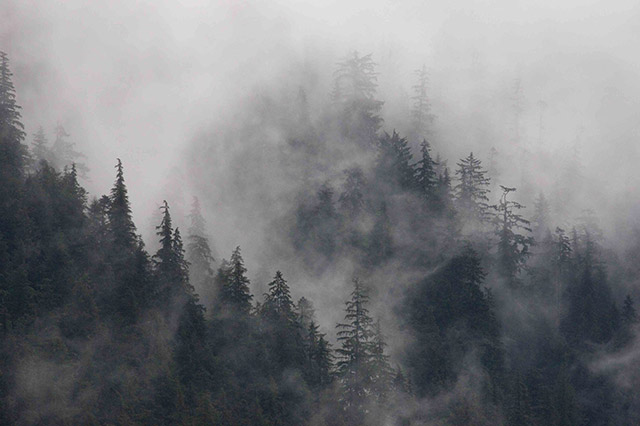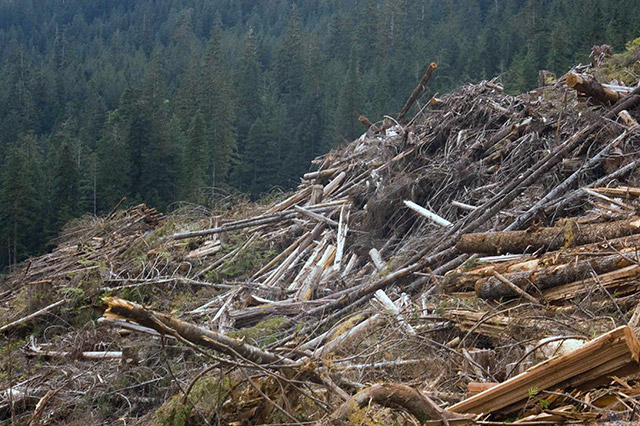|
| |
| 2. Februar 2014 |
Joint Solutions Project macht weitere Vorschläge
zum Schutz des Great Bear Rainforest |
| |
| Am 29.01.2014 haben die drei Umweltschutzgruppen Sierra Club BC, ForestEthics und Greenpeace Canada ihre mindestens zwei Jahre dauernden Verhandlungen mit den im Great Bear Rainforest tätigen Forstkonzernen abgeschlossen und ihre 82-seitigen Empfehlungen an die Provinzregierung von BC und die First Nations weitergeleitet. Die drei Umweltschutzgruppen hatten sich bereits im Jahr 2000 mit Western Forest Products, Interfor, Howe Sound Pulp and Paper, BC Timber Sales und Catalyst im sogenannten Joint Solutions Project (JSP) zusammengeschlossen, um gemeinsam das Great Bear Rainforest-Abkommen vom Februar 2006 auszuhandeln. Nach der Implementierung der Regeln des sogenannten Ecosystem-Based Management zum 31. März 2009 wurden in einem weiteren Fünfjahresplan bis März 2014 weitere Schritte zum Schutz des 6,4 Millionen Hektar großen Planungsgebietes entlang der Küste verhandelt. Wieder ist von einem „Meilenstein“ zum Schutz des Great Bear Rainforest die Rede, doch noch muss abgewartet werden, was von diesen Vorschlägen umgesetzt werden wird. |
| „Today we’re thrilled to announce that we’re one step closer to protecting British Columbia’s Great Bear Rainforest“, schrieb Valerie Langer von ForestEthics (Green Groups and Logging Companies Come Up With Joint Plan for the Great Bear Rainforest. 500.000 hectares more to safeguard forests, 29. Januar 2014). „The milestone is a set of recommendations for the final conservation step for the forests of the Great Bear Rainforest. These recommendations include setting an additional 500,000 plus hectares (1.25 million acres) of temperate rainforest off limits to logging … The two goals of the Great Bear Rainforest Agreements are to achieve high levels of human wellbeing (including maintaining a viable forest industry) and safeguarding the forest ecosystems based on the best available science (maintaining 70 per cent of the natural levels of old growth). It’s no small feat to craft solutions that reach both of those goals. |
| Key Elements of the Joint Recommendations: |
- An additional 500,000 hectares (1.25 million acres) set aside to support the conservation goal
- A resulting harvest level that can maintain a viable forestry industry
- A new approach to landscape planning that better accounts for old growth, cultural values, key wildlife habitat and riparian zones
- A legal framework and policy to support on-the-ground implementation of the recommendations
|
| Getting to an agreement with the Coast Forest Conservation Initiative companies took years of intensive negotiations and extensive technical analyses. Our joint goal was to find ways to increase conservation from the current 50 per cent to the 70 per cent level AND achieve a timber supply capable of maintaining a viable forest industry. This was no easy task. We feel these recommendations provide an elegant solution. We anxiously await the First Nations and Provincial government’s response.“ |
| |
 |
| Küstenurwald im Great Bear Rainforest |
© Klaus Pommerenke |
|
| |
| In der Presseerklärung des Ministry of Forests, Lands and Natural Resource Operations vom 29.01.2014 mit dem Titel „Great Bear Rainforest milestone reached“ heißt es: „In March 2009, the Province, First Nations, environmental groups and forest companies agreed to a five-year timeframe to review implementation of ecosystem based management land use objectives in the Great Bear Rainforest with the goal of ‚concurrently moving to high levels of ecological integrity and high levels of human well-being and if that is not possible, to make meaningful increments to both‘. The recommendations submitted today, part of the five-year implementation review of ecosystem based management, will now be evaluated by the Province, Nanwakolas Council and Coastal First Nations. Government has reconciliation agreements with both these groups of First Nations. In addition, 12 other First Nations will need to be consulted since they also have traditional territory in the Great Bear Rainforest. Ministry staff will review the recommendations for legislative and fiscal implications and implications to other resource users. First Nations will review for implications to their interests. The Province is committed to working with its First Nations’ partners to conclude the review in a timely and efficient manner. In addition, any proposed changes to the existing land use orders will be subject to a 60-day public review and comment period as required under the Land Act.“ |
| Dallas Smith vom Nanwakolas Council meinte: „Everyone involved has put a ton of time and effort into this and it’s nice to finally see these recommendations come forward. We look forward to continuing to collaborate with Joint Solutions Project as we go through the government-to-government decision-making process.“ Art Sterritt, Vorsitzender der Coastal First Nations, erklärte: „We are pleased that the Joint Solutions Project has completed its work. Coastal First Nations will now take this report to our communities for review and discussion prior to finalizing legal objectives with the Province for the Great Bear Rainforest.“ „We are extremely excited about reaching this milestone after years of hard work. We are hopeful that the Province and First Nations will find our recommendations helpful to implement the final step of the agreements. We have come a very long way to figure out the best possible outcome for conservation and forestry jobs“, sagte Jens Wieting, Forest und Climate Campaigner vom Sierra Club BC. |
| „The agreement – which will preserve another 500.000 hectares of old-growth – increases forest protection to nearly 70 per cent in the mid-coast region from the 50 per cent level already protected by 2009. The addition pushes the amount of old-growth forest preserved to more than three million hectares, an area larger than Metro Vancouver“, schrieb Gordon Hoekstra am 29.01.2014 in der Vancouver Sun (Conservation groups, timber companies reach deal to protect more of Great Bear Rainforest). „Despite an expected decrease in the amount of timber available for logging, industry says the recommendations will maintain thousands of mill-logging and silviculture jobs … Slaco, the Interfor vice-president, said the additional 500.000 hectares being protected in this latest round have not been set aside in parts. Instead, larger portion of old-growth forest must be protected in reserves, which still allows for logging in the surrounding area, he noted. Langer, the ForestEthics campaigner, said the old-growth reserves that must be set aside cover all types of forest, not just poor forest types such as pine in bog areas that would not likely have been logged anyway. The reserves include magnificent Sitka spruce valley bottoms and areas with high-quality red cedars, Langer said.“ |
| |
 |
| Bog Forest (Wald in Sumpfgebieten), der für die Forstwirtschaft uninteressant ist |
© Klaus Pommerenke |
|
| |
| Noch liegt das 82-seitige Empfehlungsschreiben des JSP an die Provinzregierung von BC und die First Nations nicht öffentlich vor, doch es ist zu erwarten, dass es nicht nur Erfolge wie den Schutz von weiteren 500.000 Hektar Urwald beinhaltet, sondern auch manch bittere Elemente für den Great Bear Rainforest. Werden womöglich weitere 100.000 Hektar bislang unberührter Urwaldgebiete unwiederbringlich den Kettensägen zum Opfer fallen? Wird das angestrebte Schutzziel „to maintain 70 % of natural levels of old growth over time“ wirklich erreicht oder mussten Abstriche gemacht werden? Das Coast Information Team – ein Expertengremium – sieht nur dann ein geringes Risiko für den Fortbestand des gesamten Ökosystems, wenn wenigstens 70 % oder mehr eines jeden natürlicherweise im Urwald vorkommenden Ökosystems erhalten wird. Schließt das „Reserve Network“ vor allem im südlichen Planungsgebiet des Great Bear Rainforest wirklich die ökologisch wertvollen Urwaldgebiete ein oder gehen als Zugeständnisse an die Forstkonzerne leicht zugängliche und ökonomisch abzuholzende Gebiete verloren? Wird es einen Einschlagstop in den empfohlenen „Wald-Reserves“ geben, bis Provinzregierung und First Nations sich geeinigt haben und irgendwann im Laufe des Jahres die Empfehlungen rechtsverbindlich umgesetzt werden? Der ursprünglich vorgesehene Stichtag 31. März 2014 ist sicherlich nicht zu halten. Art Sterritt von den Coastal First Nations rechnet bereits damit, dass es mindestens 6 Monate dauern wird, bis ein Abkommen unterzeichnet werden kann. Ohne zwischenzeitliches Einschlagsverbot könnten weitere Urwaldgebiete verloren gehen. Werden die Regeln des „Ecosystem-Based Management“ beim Holzeinschlag wirklich eingehalten werden oder wird man die gleichen brutalen Kahlschlagsbilder wie in den zurückliegenden Jahrzehnten auch zukünftig überall im Great Bear Rainforest sehen? Wer wird die Einhaltung dieser Regeln überwachen? Ein blindes Vertrauen, dass die Forstkonzerne von sich aus diese Regeln einhalten werden, darf es nicht geben. Auch ein Vertrauen, dass seitens der Provinzregierung eine Kontrolle der Forstkonzerne – vor allem von BC Timber Sales – erfolgen wird, wäre fehl am Platze. |
| |
 |
| Noch unberührter Küstenregenwald im Great Bear Rainforest |
© Klaus Pommerenke |
|
| |
| Im Folgenden finden Sie den Bericht von Mark Hume über die nach zähen Verhandlungen erzielten Empfehlungen des JSP an die Provinzregierung und die 27 verschiedenen First Nations-Gruppen (Stakeholders reach deal on Great Bear Rainforest, The Globe & Mail, 29.01.2014): |
| „After years of conflict that featured blockades and market boycotts, environmental groups and the forest industry have finally agreed on what can be logged and what must be protected in B.C.’s Great Bear Rainforest. A detailed plan has gone forward to the provincial government and 27 First Nations that reside in the area. If approved by those entities, it will lead to the protection of 70 per cent of the land base in a rugged coastal region that covers 6.4 million hectares on the mainland coast. The agreement comes after two years of intensive negotiations between three environmental groups and five forest companies in what is known as the Joint Solutions Project. Those talks were preceded by years of protest which saw activists blocking roads and chaining themselves to logging equipment. A market campaign by Greenpeace in the United States and Europe finally brought industry to the table, leading to a groundbreaking deal in 2009 in which the B.C. government, First Nations, environmental groups and industry agreed to fully protect some areas, while following scientifically prescribed logging plans in others. In that broad agreement, about 50 per cent of the area was protected. The final deal increases the current protected area by 20 per cent. In the process of getting the agreement, said Ric Slaco, vice-president and chief forester for Interfor, the former protagonists had to learn how to communicate about an emotionally divisive issue. ‚It wasn’t easy, I can tell you that‘, he said in an interview Wednesday. He agreed that the forest industry did give up some areas it wanted, but so did the environmentalists as the plan permits some old-growth logging. ‚This is not about capitulating. This is about understanding‘, said Mr. Slaco, whose company produces more than one billion board feet of lumber a year in B.C. ‚You know we’re bringing new thinking to an old, traditional issue of conflict.‘ The agreement is a key hurdle in a land use planning process that began about 15 years ago, when the forest industry first sought to end ‚the war in the woods‘ by seeking a mutually acceptable formula for logging in the Great Bear Rainforest. The goal, Mr. Slaco said, is to protect the most precious areas, while also allowing logging on a scale that will support local economies. ‚So we’ve been … looking at all the different landscape areas … trying to find the right balance in terms of achieving those two objectives in a way that would make sense for us … and for the conservation groups‘, Mr. Slaco said. Valerie Langer, of ForestEthics Solutions, said the agreement ‚maximizes conservation while minimizing the impact to the timber supply‘. Most of the area will be protected, she said, and the logging that does occur will be to high standards known as ecosystem-based management. Ms. Langer said she’s hopeful the government and First Nations will approve the agreement by March 31, 2014, a deadline that was set for final settlement when the broad agreement was first reached in 2009. Art Sterritt, executive director of Coastal First Nations, said 27 bands have to be consulted about the agreement before it can be finalized and he can’t see that happening by March 31. ‚It’s a huge decision. I can’t imagine us getting this done in anything less than six months‘, he said. But Mr. Sterritt said the deadline can be pushed back, and he’s confident final approval, by governments for the province and First Nations, will be given later this year. ‚I do believe we’re going to complete this. There’s no doubt about it‘, he said. ‚You know this is more a process of fine tuning. We don’t think anything is going to jump out at us that we won’t be able to solve.‘ … “ |
| |
 |
Kahlschläge und Holzverschwendung: Beides wird es auch zukünftig
trotz der neuen Vorschläge im Great Bear Rainforest geben |
© Klaus Pommerenke |
|
| |
| Abschließend ist die Presseerklärung des Joint Solutions Project zu den ausgehandelten Empfehlungen wiedergegeben: |
| „Forest Companies & Environmental Groups Deliver Joint Recommendations for the Great Bear Rainforest |
| VANCOUVER, B.C. – Joint recommendations to achieve final implementation of ecosystem-based management (EBM) in the Great Bear Rainforest have been reached among five forest product businesses and three leading environmental groups who together form the Joint Solutions Project (JSP). |
| The recommendations include the scope of future logging along B.C.’s central and north coasts and conservation measures to support ecological low risk. The recommendations have been provided to the Province and First Nations at their request. |
| The joint recommendations are the culmination of years of intensive collaborative work and technical analysis. They represent the major input for the final step in the landmark Great Bear Rainforest Agreement, which was announced in 2006, and endorsed by the provincial government, First Nations, environmental groups and forest companies. |
| The recommendations have been delivered to the Province and First Nations who are the decision-makers regarding implementation of the Great Bear Rainforest Agreements which will protect the rainforest while at the same time improving social, cultural and economic well-being. The recommendations will also support the 2014 review of the current legal objectives for the region. |
| ‚Collaboration has been the cornerstone in this significant achievement. We are committed to supporting the Province and First Nations as they begin the complex analysis and detailed discussions needed to complete the final chapter of this historic agreement‘, said Ric Slaco, chair of the Coast Forest Conservation Initiative and Interfor’s vice president and chief forester. ‚Once completed, this agreement will provide greater economic certainty for our communities, marketplace recognition for our products, and support additional investment in the region in the years ahead.‘ |
| ‚It’s not every day that environmental groups and big forestry businesses put forward joint recommendations that are good for the forests and fair to the forest sector in the region‘, said Valerie Langer, ForestEthics Solutions on behalf of Greenpeace and Sierra Club BC. ‚There is a lot of anticipation from around the world to see this model succeed. Our focus now will be working with the Province and First Nations to make sure we come through the final process with a win we can all celebrate.‘ |
| JSP was established in 2000 by a group of B.C. coastal forest companies and environmental organizations. In the years since, it has participated in land use planning and technical analysis to inform decision-making aimed at reducing conflict over logging and creating a world-class conservation plan for the 64,000 square kilometre Great Bear Rainforest. |
| JSP members include ForestEthics Solutions, Greenpeace, Sierra Club BC, BC Timber Sales, Catalyst Paper Corporation, Howe Sound Pulp & Paper, Interfor and Western Forest Products.“ |
| |
 zurück zurück |
|
|

